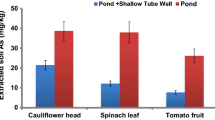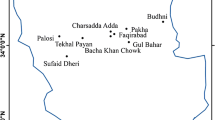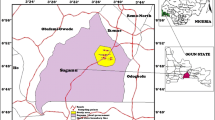Abstract
The current study was conducted to evaluate the arsenic (As) and fluoride (F−) concentrations in growing media (stored rainwater and soil), of district Tharparkar, Pakistan. The bioaccumulation/transportation of As and F from growing media to different types of vegetables (wild cucumis, Indian squish and cluster bean) was evaluated. Total concentrations of As and F− in stored rainwater samples were observed up to 585 μg/L and 32.4 mg/L, respectively, exceeding many folds higher than WHO provisional guideline values. The As and F− contents in soil samples of nine agricultural sites were found in the range of 121–254 mg/kg and 115–478 mg/kg, respectively. The highest contents of As and F− were observed in wild cucumis as compared to Indian squish and cluster bean (p < 0.05), grown in the same agricultural field. The bioaccumulation factors of As and F− were to be > 4.00, indicating the high rate of transportation of As and F− from growing media to vegetables. A significant positive correlation of As and F− in vegetables with their concentrations in soil and water was observed (r > 0.60 with p < 0.05). The risk assessment elucidated that the population of different age group consuming local vegetables and drinking water contaminated with As and F− may have adverse health effects.
Graphical Abstract


Similar content being viewed by others
References
Abedin, M. J., Cresser, M. S., Meharg, A. A., Feldmann, J., & Cotter-Howells, J. (2002). Arsenic accumulation and metabolism in rice (Oryza sativa L.). Environmental Science and Technology, 36(5), 962–968.
Ando, M., Tadano, M., Asanuma, S., Tamura, K., Matsushima, S., Watanabe, T., et al. (1998). Health effects of indoor fluoride pollution from coal burning in China. Environmental Health Perspectives, 106(5), 239.
Ayoob, S., & Gupta, A. K. (2006). Fluoride in drinking water: a review on the status and stress effects. Critical Reviews in Environmental Science and Technology, 36(6), 433–487.
Bae, M., Watanabe, C., Inaoka, T., Sekiyama, M., Sudo, N., Bokul, M. H., et al. (2002). Arsenic in cooked rice in Bangladesh. The Lancet, 360(9348), 1839–1840.
Baig, J. A., & Kazi, T. G. (2012). Translocation of arsenic contents in vegetables from growing media of contaminated areas. Ecotoxicology and Environmental Safety, 75, 27–32.
Baig, J. A., Kazi, T. G., Arain, M. B., Afridi, H. I., Kandhro, G. A., Sarfraz, R. A., et al. (2009). Evaluation of arsenic and other physico-chemical parameters of surface and ground water of Jamshoro, Pakistan. Journal of Hazardous Materials, 166(2–3), 662–669.
Baig, J. A., Kazi, T. G., Shah, A. Q., Afridi, H. I., Kandhro, G. A., Khan, S., et al. (2011). Evaluation of arsenic levels in grain crops samples, irrigated by tube well and canal water. Food and Chemical Toxicology, 49(1), 265–270.
Berg, M., Stengel, C., Trang, P. T. K., Hung Viet, P., Sampson, M. L., Leng, M., et al. (2007). Magnitude of arsenic pollution in the Mekong and Red River Deltas—Cambodia and Vietnam. Science of the Total Environment, 372(2), 413–425. https://doi.org/10.1016/j.scitotenv.2006.09.010.
Bhattacharya, P., Claesson, M., Bundschuh, J., Sracek, O., Fagerberg, J., Jacks, G., et al. (2006). Distribution and mobility of arsenic in the Rio Dulce alluvial aquifers in Santiago del Estero Province, Argentina. Science of the Total Environment, 358(1–3), 97–120.
Bhattacharya, P., Welch, A. H., Stollenwerk, K. G., McLaughlin, M., Bundschuh, J., & Panaullah, G. (2007). Arsenic in the environment: Biology and chemistry. Science of the Total Environment, 379, 109–120.
Börzsönyi, M., Bereczky, A., Rudnai, P., Csanady, M., & Horvath, A. (1992). Epidemiological studies on human subjects exposed to arsenic in drinking water in Southeast Hungary. Archives of Toxicology, 66(1), 77–78. https://doi.org/10.1007/bf02307274.
Brahman, K. D., Kazi, T. G., Afridi, H. I., Naseem, S., Arain, S. S., & Ullah, N. (2013a). Evaluation of high levels of fluoride, arsenic species and other physicochemical parameters in underground water of two sub districts of Tharparkar, Pakistan: A multivariate study. Water Research, 47(3), 1005–1020.
Brahman, K. D., Kazi, T. G., Afridi, H. I., Naseem, S., Arain, S. S., Wadhwa, S. K., et al. (2013b). Simultaneously evaluate the toxic levels of fluoride and arsenic species in underground water of Tharparkar and possible contaminant sources: A multivariate study. Ecotoxicology and Environmental Safety, 89, 95–107.
Brahman, K. D., Kazi, T. G., Afridi, H. I., Rafique, T., Baig, J. A., Arain, S. S., et al. (2014). Evaluation of fresh and stored rainwater quality in fluoride and arsenic endemic area of Thar Desert, Pakistan. Environmental Monitoring and Assessment, 186(12), 8611–8628.
Buchhamer, E. E., Blanes, P. S., Osicka, R. M., & Giménez, M. C. (2012). Environmental risk assessment of arsenic and fluoride in the Chaco Province, Argentina. Journal of Toxicology and Environmental Health, Part A, 75, 1437–1450.
Bundschuh, J., et al. (2004). Groundwater arsenic in the Chaco-Pampean plain, Argentina: case study from Robles county, Santiago del Estero province. Applied Geochemistry, 19(2), 231–243.
Bustingorri, C., & Lavado, R. S. (2014). Soybean as affected by high concentrations of arsenic and fluoride in irrigation water in controlled conditions. Agricultural Water Management, 144, 134–139.
Carrillo-Rivera, J., Cardona, A., & Edmunds, W. (2002a). Use of abstraction regime and knowledge of hydrogeological conditions to control high-fluoride concentration in abstracted groundwater: San Luis Potosı basin, Mexico. Journal of hydrology, 261(1–4), 24–47.
Carrillo-Rivera, J. J., Cardona, A., & Edmunds, W. M. (2002b). Use of abstraction regime and knowledge of hydrogeological conditions to control high-fluoride concentration in abstracted groundwater: San Luis Potosí basin, Mexico. Journal of Hydrology, 261(1), 24–47. https://doi.org/10.1016/S0022-1694(01)00566-2.
Das, K., Dey, U., & Mondal, N. K. (2016). Deleneation of groundwater quality in the presence of fluoride in selected villages of Simlapal block, Bankura district, West Bengal, India. Sustainable Water Resources Management, 2(4), 439–451.
Das, H., Mitra, A. K., Sengupta, P., Hossain, A., Islam, F., & Rabbani, G. (2004). Arsenic concentrations in rice, vegetables, and fish in Bangladesh: A preliminary study. Environment International, 30(3), 383–387.
Dey, R. K., Swain, S. K., Mishra, S., Sharma, P., Patnaik, T., et al. (2012). Hydrogeochemical processes controlling the high fluoride concentration in groundwater: A case study at the Boden block area, Orissa, India. Environmental Monitoring and Assessment, 184(5), 3279–3291.
Duxbury, J., Mayer, A., Lauren, J., & Hassan, N. (2003). Food chain aspects of arsenic contamination in Bangladesh: effects on quality and productivity of rice. Journal of Environmental Science and Health, Part A, 38(1), 61–69.
Fantong, W. Y., Satake, H., Ayonghe, S. N., Suh, E. C., Adelana, S. M. A., Fantong, E. B. S., et al. (2010). Geochemical provenance and spatial distribution of fluoride in groundwater of Mayo Tsanaga River Basin, Far North Region, Cameroon: Implications for incidence of fluorosis and optimal consumption dose. Environmental Geochemistry and Health, 32(2), 147–163. https://doi.org/10.1007/s10653-009-9271-4.
Fantong, W. Y., Takounjou, A. F., Fantong, E. B., Banseka, H. S., Gwanfogbe, C. D., Ayonghe, S. N., et al. (2013). Increased risk of fluorosis and methemoglobinemia diseases from climate change: Evidence from groundwater quality in Mayo Tsanaga River Basin, Cameroon. J. Cam. Acad. Sci, 11(1), 55–60.
Farooqi, A., Masuda, H., & Firdous, N. (2007). Toxic fluoride and arsenic contaminated groundwater in the Lahore and Kasur districts, Punjab, Pakistan and possible contaminant sources. Environmental Pollution, 145(3), 839–849.
Ferreccio, C., & Sancha, A. M. (2006). Arsenic exposure and its impact on health in Chile. Journal of Health, Population and Nutrition, 164-175.
Finkelman, R. B., Orem, W., Castranova, V., Tatu, C. A., Belkin, H. E., Zheng, B., et al. (2002). Health impacts of coal and coal use: Possible solutions. International Journal of Coal Geology, 50(1–4), 425–443.
Gao, H.-J., Zhao, Q., Zhang, X.-C., Wan, X.-C., & Mao, J.-D. (2014). Localization of fluoride and aluminum in subcellular fractions of tea leaves and roots. Journal of Agricultural and Food Chemistry, 62(10), 2313–2319.
Gómez, M. L., Blarasin, M. T., & Martínez, D. E. (2009). Arsenic and fluoride in a loess aquifer in the central area of Argentina. Environmental Geology, 57, 143–155.
González-Horta, C., et al. (2015). A concurrent exposure to arsenic and fluoride from drinking water in Chihuahua, Mexico. International Journal of Environmental Research and Public Health, 12(5), 4587–4601.
Guo, H., & Wang, Y. (2005). Geochemical characteristics of shallow groundwater in Datong basin, northwestern China. Journal of Geochemical Exploration, 87(3), 109–120.
Guo, X., Liu, Z., Huang, C., & You, L. (2006). Levels of arsenic in drinking-water and cutaneous lesions in Inner Mongolia. Journal of Health, Population and Nutrition, 24(2), 214–220.
Irigoyen-Camacho, M., Pérez, A. G., González, A. M., & Alvarez, R. H. (2016). Nutritional status and dental fluorosis among schoolchildren in communities with different drinking water fluoride concentrations in a central region in Mexico. Science of the Total Environment, 541, 512–519.
Jamali, M., et al. (2008). Use of sewage sludge after liming as fertilizer for maize growth. Pedosphere, 18(2), 203–213.
Jha, S., Nayak, A., & Sharma, Y. (2011). Site specific toxicological risk from fluoride exposure through ingestion of vegetables and cereal crops in Unnao district, Uttar Pradesh, India. Ecotoxicology and Environmental Safety, 74(4), 940–946.
Jha, S., Singh, R., Damodaran, T., Mishra, V., Sharma, D., & Rai, D. (2013). Fluoride in groundwater: Toxicological exposure and remedies. Journal of Toxicology and Environmental Health, Part B, 16(1), 52–66.
Juhasz, A. L., Smith, E., Weber, J., Rees, M., Rofe, A., Kuchel, T., et al. (2006). In vivo assessment of arsenic bioavailability in rice and its significance for human health risk assessment. Environmental Health Perspectives, 114(12), 1826.
Kazi, T. G., Arain, M. B., Baig, J. A., Jamali, M. K., Afridi, H. I., Jalbani, N., et al. (2009). The correlation of arsenic levels in drinking water with the biological samples of skin disorders. Science of the Total Environment, 407(3), 1019–1026.
Khan, A., Khan, S., Khan, M. A., Qamar, Z., & Waqas, M. (2015). The uptake and bioaccumulation of heavy metals by food plants, their effects on plants nutrients, and associated health risk: A review. Environmental Science and Pollution Research, 22(18), 13772–13799.
Khandare, A. L., & Rao, G. S. (2006). Uptake of fluoride, aluminum and molybdenum by some vegetables from irrigation water. Journal of Human Ecology, 19(4), 283–288.
Kurzius-Spencer, M., Harris, R. B., Hartz, V., Roberge, J., Hsu, C.-H., O’rourke, M. K., et al. (2016). Relation of dietary inorganic arsenic to serum matrix metalloproteinase-9 (MMP-9) at different threshold concentrations of tap water arsenic. Journal of Exposure Science & Environmental Epidemiology, 26(5), 445.
Lu, Y., Sun, Z., Wu, L., Wang, X., Lu, W., & Liu, S. (2000). Effect of high-fluoride water on intelligence in children. Fluoride, 33(2), 74–78.
Madeira, A., De Varennes, A., Abreu, M., Esteves, C., & Magalhães, M. (2012). Tomato and parsley growth, arsenic uptake and translocation in a contaminated amended soil. Journal of Geochemical Exploration, 123, 114–121.
Martínez-Acuña, M. I., Mercado-Reyes, M., Alegría-Torres, J. A., & Mejía-Saavedra, J. J. (2016). Preliminary human health risk assessment of arsenic and fluoride in tap water from Zacatecas, México. Environmental Monitoring and Assessment, 188(8), 476.
Milton, A. H., Smith, W., Rahman, B., Hasan, Z., Kulsum, U., Dear, K., et al. (2005). Chronic arsenic exposure and adverse pregnancy outcomes in Bangladesh. Epidemiology, 16(1), 82–86.
Mukherjee, S. C., Saha, K. C., Pati, S., Dutta, R. N., Rahman, M. M., Sengupta, M. K., et al. (2005). Murshidabad—one of the nine groundwater arsenic-affected districts of West Bengal, India. Part II: Dermatological, neurological, and obstetric findings. Clinical Toxicology, 43(7), 835–848.
Naseem, S., Rafique, T., Bashir, E., Bhanger, M. I., Laghari, A., & Usmani, T. H. (2010). Lithological influences on occurrence of high-fluoride groundwater in Nagar Parkar area, Thar Desert, Pakistan. Chemosphere, 78(11), 1313–1321.
Nguyen, V. A., Bang, S., Viet, P. H., & Kim, K.-W. (2009). Contamination of groundwater and risk assessment for arsenic exposure in Ha Nam province, Vietnam. Environment International, 35(3), 466–472.
Nickson, R., McArthur, J., Shrestha, B., Kyaw-Myint, T., & Lowry, D. (2005). Arsenic and other drinking water quality issues, Muzaffargarh District, Pakistan. Applied Geochemistry, 20(1), 55–68.
Okibe, F., Ekanem, E., Paul, E., Shallangwa, G., Ekwumemgbo, P., Sallau, M., et al. (2010). Fluoride content of soil and vegetables from irrigation farms on the bank of river Galma, Zaria, Nigeria. Australian Journal of Basic and Applied Sciences, 4(5), 779–784.
Organization, W. H. (2008). Guidelines for drinking-water quality [electronic resource]: Incorporating, 1st and 2nd addenda, vol. 1, Recommendations.
Orloff, K., Mistry, K., & Metcalf, S. (2009). Biomonitoring for environmental exposures to arsenic. Journal of Toxicology and Environmental Health B, 12, 509–524.
Patel, K., Shrivas, K., Brandt, R., Jakubowski, N., Corns, W., & Hoffmann, P. (2005). Arsenic contamination in water, soil, sediment and rice of central India. Environmental Geochemistry and Health, 27(2), 131–145.
Poureslami, H. R., Khazaeli, P., & Noori, G. R. (2008). Fluoride in food and water consumed in Koohbanan (Kuh-e Banan), Iran. Fluoride, 41(3), 216–219.
Rafique, T., Naseem, S., Bhanger, M. I., & Usmani, T. H. (2008). Fluoride ion contamination in the groundwater of Mithi sub-district, the Thar Desert, Pakistan. Environmental Geology, 56(2), 317–326.
Rafique, T., Naseem, S., Usmani, T. H., Bashir, E., Khan, F. A., & Bhanger, M. I. (2009). Geochemical factors controlling the occurrence of high fluoride groundwater in the Nagar Parkar area, Sindh, Pakistan. Journal of Hazardous Materials, 171, 424–430.
Rager, J. E., Bailey, K. A., Smeester, L., Miller, S. K., Parker, J. S., Laine, J. E., et al. (2014). Prenatal arsenic exposure and the epigenome: altered microRNAs associated with innate and adaptive immune signaling in newborn cord blood. Environmental and Molecular Mutagenesis, 55(3), 196–208.
Roychowdhury, T., Tokunaga, H., & Ando, M. (2003). Survey of arsenic and other heavy metals in food composites and drinking water and estimation of dietary intake by the villagers from an arsenic-affected area of West Bengal, India. Science of the Total Environment, 308(1–3), 15–35.
Ruan, J., Ma, L., Shi, Y., & Han, W. (2004). The impact of pH and calcium on the uptake of fluoride by tea plants (Camellia sinensis L.). Annals of Botany, 93(1), 97–105.
Shah, M. T., & Danishwar, S. (2003). Potential fluoride contamination in the drinking water of Naranji area, northwest frontier province, Pakistan. Environmental Geochemistry and Health, 25(4), 475–481.
Shrestha, B. (2002). Drinking water quality: Future directions for UNICEF in Pakistan Consultancy Report 2 of 3. Islamabad: Water Quality, SWEET Project, UNICEF Pakistan.
Smedley, P. L., & Kinniburgh, D. (2002). A review of the source, behaviour and distribution of arsenic in natural waters. Applied Geochemistry, 17(5), 517–568.
Sofuoglu, S. C., & Kavcar, P. (2008). An exposure and risk assessment for fluoride and trace metals in black tea. Journal of Hazardous Materials, 158(2–3), 392–400.
Tahir, M. (2000). Report on arsenic in groundwater of Attock and Rawalpindi Districts. Pakistan Council of Research in Water Resources (PCRWR), Ministry of Science & Technology, Government of Pakistan.
Tsuji, J. S., Perez, V., Garry, M. R., & Alexander, D. D. (2014). Association of low-level arsenic exposure in drinking water with cardiovascular disease: A systematic review and risk assessment. Toxicology, 323, 78–94.
Wang, X. C., Kawahara, K., & Guo, X. J. (1999). Fluoride contamination of groundwater and its impact on human health in Inner Mongolia area. Aqua, 48, 146–153.
Xiong, X., Liu, J., He, W., Xia, T., He, P., Chen, X., et al. (2007). Dose–effect relationship between drinking water fluoride levels and damage to liver and kidney functions in children. Environmental Research, 103(1), 112–116.
Yadav, R. K., Sharma, S., Bansal, M., Singh, A., Panday, V., & Maheshwari, R. (2012). Effects of fluoride accumulation on growth of vegetables and crops in Dausa District, Rajasthan, India. Advances in Bioresearch, 3(4).
Yadav, P., Singh, B., Garg, V., Mor, S., & Pulhani, V. (2017). Bioaccumulation and health risks of heavy metals associated with consumption of rice grains from croplands in Northern India. Human and Ecological Risk Assessment: An International Journal, 23(1), 14–27.
Yang, C.-Y., Chang, C.-C., Tsai, S.-S., Chuang, H.-Y., Ho, C.-K., & Wu, T.-N. (2003). Arsenic in drinking water and adverse pregnancy outcome in an arseniasis-endemic area in northeastern Taiwan. Environmental Research, 91(1), 29–34. https://doi.org/10.1016/S0013-9351(02)00015-4.
Yoshida, T., Yamauchi, H., & Sun, F. G. (2004). Chronic health effects in people exposed to arsenic via the drinking water: Dose–response relationships in review. Toxicology and Applied Pharmacology, 198, 243–252.
Zheng, B., Yu, X., Zhand, J., & Zhou, D. (1996). Environmental geochemistry of coal and arsenic in Southwest Guizhou, P.R. China. 30th International Geological Congress Abstracts 3, 410
Acknowledgements
The authors are grateful for the financial support of the Higher Education commission (HEC), Islamabad, Pakistan (Pin # 2Ps1-182).
Author information
Authors and Affiliations
Corresponding author
Rights and permissions
About this article
Cite this article
Kazi, T.G., Brahman, K.D., Baig, J.A. et al. Bioaccumulation of arsenic and fluoride in vegetables from growing media: health risk assessment among different age groups. Environ Geochem Health 41, 1223–1234 (2019). https://doi.org/10.1007/s10653-018-0207-8
Received:
Accepted:
Published:
Issue Date:
DOI: https://doi.org/10.1007/s10653-018-0207-8




